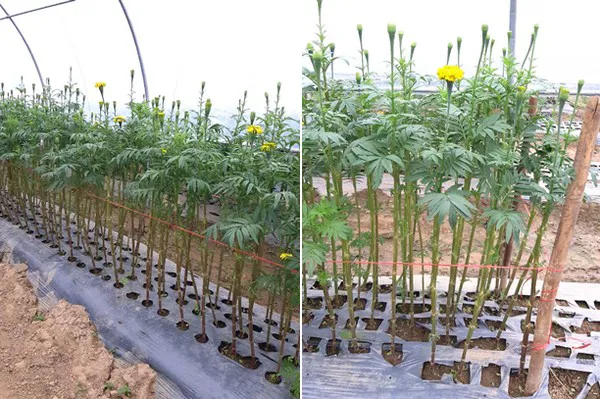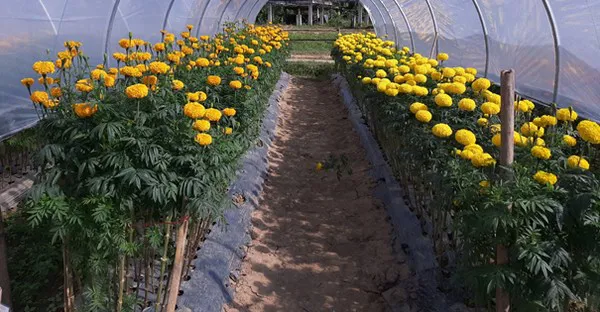Marigolds, Tegetes erecta, have increased in popularity over the last thirty years and are grown in most countries for pot, bedding and landscape purposes. But what about marigolds as cut flowers? They were very popular 50 year ago, but according to Ameriseed, these cut flowers, referred to as "Hedge Marigolds", were no longer being improved or suitable for the cut flower market. Therefore, 20 years ago, they decided to started a new breeding program to produce various “Tailor Made” intermediate and tall varieties of Marigolds suitable for the many different facets and uses worldwide. Over the years, Ameriseed has become one of the leading Marigold breeding companies and has developed 53 special use marigold varieties for different climates and growing locations.
This Summer 2020, AmeriSeed designed a trial to assess the possibilities and opportunities for cut flower growers and producers to grow single stem marigold cut flower marigolds for vase and bouquet use.

History marigold cut flower
Fifty years ago marigolds were very popular as cut flowers for vases and bouquets, explains AmeriSeed's marketing director, Beam Sailern Senhuk. "These cut flower marigold varieties were referred to as “Hedge Marigolds” and most of the breeding work was done by Bodger Seeds in Lompoc, California. Thirty five years ago Bodger’s original ”Hedge Marigold” varieties were introduced to Vietnam, Thailand, India and Indonesia where flowers were used for religious purposes including garland production. Twenty years ago, AmeriSeed decided that these older types of general purpose “Hedge Marigolds” were no longer being improved or suitable for the cut flower markets worldwide so a new breeding program was started to produce various “Tailor Made” intermediate and tall varieties of Marigolds suitable for the many different facets and uses worldwide."
Potential for vase and bouquet use
According to Senhuk, the marigold has a lot of advantages for a cut flower grower. "Unlike the cut flower helianthus, marigolds are branching allowing growers to harvest multiple stems per plant. On top of that, single stem Marigolds produce longer, stronger and uniform stems with a longer shelf life."
This Summer 2020, AmeriSeed designed a trial to assess the possibilities and opportunities for cut flower growers and producers to grow single stem marigold cut flower marigolds for vase and bouquet use.
"It is important to choose the right varieties of Marigold for this specialized type of production." AmeriSeed’s Summer trials indicate that Bali, Bindi, Sumati and White Swan are currently the most suitable varieties.
Growing techniques to produce single stem Marigolds
To give a good impression of the cultivation of the marigold cut flowers, Senhuk explains three different stages of production below; the plug stage, the transplant stage and the harvest stage.
- Plug Stage
"Sow the Marigold seeds in 200 cell plug trays using peat moss media (EC = 0.5 & pH = 6.5 – 7.0) and lightly cover seeds with peat media or vermiculite. Place seedling tray in germination room for 3-5 days. After germination, move seedling tray outside and expose to full sunlight. 15-20 days after sowing, young plants are ready to be transplanted into beds. Do not allow plants to stretch or grow tall in the plug tray."
- Transplant Stage
"Then, the plug should be transplanted to a loamy soil (pH 6.5 – 7.5) either for open field or greenhouse production with plant spacing between each plant of 10 cm. The first week after transplant, use only water for fertigation. 2-3 weeks after transplant, use fertilizer N 50 ppm form calcium nitrate (15-0-0) to promote vertical growth. From 3rd - 4th week, use fertilizer N 100 ppm by N-P-K ratio: 2:1:3 and supplement with Calcium and Boron as a micro element mix 2 times per week. 3 weeks after transplant, trim side branches every week as per photo below. Lower leaves and old leaves must be removed to increase air ventilation and prevent fungi. From 5th week to harvest, use fertilizer N 150 ppm by N-P-K ratio: 2:1:3 and supplement with Calcium-Boron as previously mentioned."

Trimming/pruning removal of side branches and older leaves

- Harvest
Most varieties are ready to harvest 40 – 45 days after transplanting. The ideal harvesting time for single stem marigold is when blooms are about 80% open and still with a little green color in the center. Use a clean sharp knife and cut about 2 inches above the soil.

For more information:
Ameriseed
Email: sales@ameriseed.net
www.ameriseed.net
